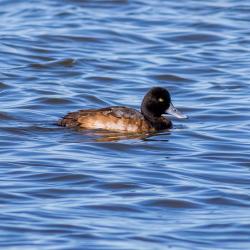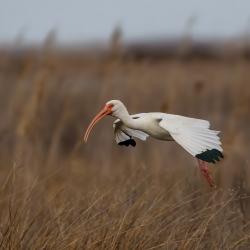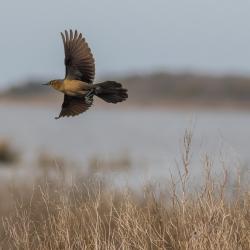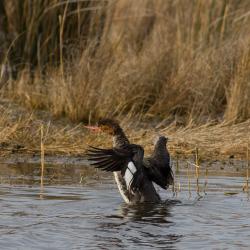Pea Island Wildlife Refuge was by far our most prolific birding destination on OBX, NC, and it is an absolute must see for birding enthusiasts and wildlife photographers alike. Pea Island Wildlife Refuge has 5,834 acres of land in addition to 25,700 acres of water, and is approximately 13 miles long with a width that varies from a half mile to a full mile. The environment is wildly diverse, with ocean beaches and high and dry sand dunes, fresh and brackish soundside ponds, low-lying salt flats, and salt marshes.
Considering this diverse range of unique habitats, it's no surprise that more than 400 wildlife species call the Pea Island Wildlife Refuge home. The US Fish and Wildlife Service estimates that at any given time the Pea Island Wildlife Refuge is home to 365 species of birds, 25 species of mammals, 24 species of reptiles, and 5 different kinds of amphibians.
The sweet spot during our bird photography trip appeared to be the trail to the left of the Pea Island Wildlife Refuge visitor's center as It seemed to be a great feeding spot for various ducks, pelicans, egrets, ibis, and herons as well as a haven for woodland birds. The best time to go photograph birds seemed to be in early morning week days to capture the waterfowl such as ducks, pelicans, egrets, ibis, and herons, but we were also able to get some great photographs of woodland birds such as the Yellow Rumped Warbler, Brewer's Blackbird and the elusive Meadowlark in the brush along the pathway and in the grass later in the day.
We spent many a day at Pea Island Wildlife Refuge photographing and watching the crazy antics of these birds. As a casual wildlife lover, you can miss these odd events as you don't spend quite as much time as a photographer waiting to get the perfect photograph. Looking through a high powered photography lens doesn't hurt either to capture things that you may miss with the naked eye.
While waiting for a perfect photograph of an interaction between a Great Blue Heron and a American Coot, the heron was caught kicking a coot. A Great White Egret was seen moving his neck like it was being snake charmed right before snagging a bite out of the water. The contortions of the American White Pelican's bill while feeding were just hilarious, which wasn't fully appreciated until viewing photographs. Unfortunately, we didn't get a great photographs of these events. We did, however, catch the Pied-Billed Grebe eating a rather large Bass.
The nervous Nellies of the bird bunch were the American Coot. These rotund waterfowl would stampede into frantic flight at the slightest movement while all the other waterfowl stayed put, apparently accustomed to their frequent flying frenzy. Ducks came in second in this category.
It is important when approaching and photographing birds that you are quiet, move slowly and stay as still as possible. Since there were three of us, we would move together single file as a tight unit to appear as one instead of three people, walking slowly, stopping, and then inching closer again. We were able to creep up to the edge of the water. Even when we were quiet and still, if someone quickly or noisily came down the path some distance away, it would startle the birds, and many would leave.
The variety of ducks and brilliant colors were amazing to see. We saw Pintails, Red-headed, Shoveler, Hooded Merganzer, Black-Headed, Bufflehead, Blue Winged Teal Ducks to name a few. Seeing the Buffehead Ducks rolling onto their back in their unique preening ritual was particularly comical to see. Egrets, herons, and Ibis flocked together feeding along the edge of a nearby outcropping of vegetation, but the egrets ruled the roost and seems to put the other birds in their place when they were crowding his hunting ground.
Other areas that worked well for photographing a variety of birds were the little salt flats by the road on a windy day. It was overflowing with Snow Geese, Pintail Ducks, Baird Sandpipers, and Tundra Swans. It was poetry in motion watching the Baird Sandpipers flit back and forth in perfect choreography. We were excited to find the Snow Geese at Pea Island Wildlife Refuge in the largest concentration on our birding photography adventure.
Snow Geese breed in the Arctic Tundra and winter in farmlands, lakes and coastal areas in the American south, southwest and east coast. These attractive geese occur only in North America and make an annual round trip journey of more than 5,000 miles at speeds of 50 mph or more. Seen in flight, Snow Geese adults are white with jet black wing tips. Occasionally, you will see a grayish goose among them, and they are, in fact, Snow Geese and not another breed. These Snow Geese are called blues and come from breeding slight variations of color within the group. These beautiful Snow Geese look quite comical with their heads plunged into the muddy ground in ostrich like fashion for a bite to eat.

































































